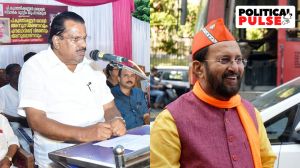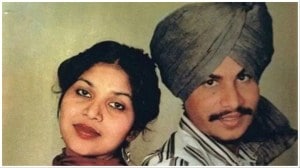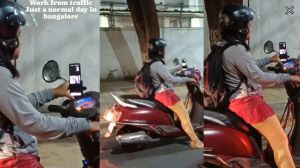- India
- International
Did a painter actually prophesy Gandhi’s assassination?
Rashtrapati Bhavan’s treasury of paintings on Mahatma Gandhi present him as leader, who identified with people and knew their pain
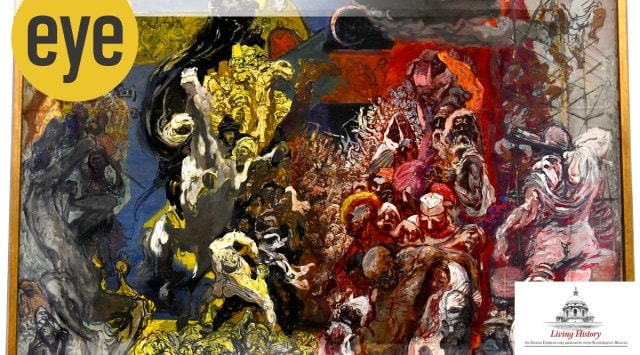 Polish painter Feliks Topolski's reworked painting of Gandhi's assassination (Courtesy: Rashtrapati Bhavan Archives)
Polish painter Feliks Topolski's reworked painting of Gandhi's assassination (Courtesy: Rashtrapati Bhavan Archives)As you walk across the corridor of the Rashtrapati Bhavan Cultural Centre (RBCC) and reach the open hall leading to the main West Hall, there hangs a painting that portrays the assassination of Mahatma Gandhi. Curiously, Polish painter Feliks Topolski had originally drawn this painting in 1946 as if he had a premonition of Gandhi’s violent death. The painting, titled The East, is a reworked version done in 1948.
Death is macabre even if it is depicted on a canvas, but through this painting, Gandhi is exalted even in his death. There is much debate on the aesthetics and the sense of prophecy of the acclaimed painter’s brush, but Topolski’s own version is not known.
 AH Muller’s painting of Gandhi at the Banquet Hall in Rashtrapati Bhavan (Courtesy: Rashtrapati Bhavan Archives)
AH Muller’s painting of Gandhi at the Banquet Hall in Rashtrapati Bhavan (Courtesy: Rashtrapati Bhavan Archives)
The RBCC’s West Hall and adjacent ceremonial hall are often used for hosting receptions for visiting heads of states, at-home ceremonies, official banquets and functions. This painting is often seen more as an enigma than as an object of curiosity to the discerning eye. It echoes noted English historian Arnold Toynbee, who wrote after Gandhi’s assassination: “Henceforth, mankind will ask its prophets, ‘Are you willing to live in the slum of politics?’” Gandhi’s willingness to “live in this slum” elevates him to the level of a prophet. The Rashtrapati Bhavan, the highest constitutional seat of the Republic, treasures many visuals on the life of Mahatma Gandhi.
A historical photograph of Gandhi’s first meeting with the Mountbattens in 1947, to work out the process of transition from British rule to independence, has been rendered into a painting on canvas by MH Ramoo. It is currently placed in the Long Drawing Room of the Rashtrapati Bhavan. A portrait by AH Muller adorns the Banquet Hall, showing Gandhi clad in his trademark dhoti, a watch dangling from his waist, feet thrust into a simple pair of sandals, as if welcoming guests with folded hands and an innocent smile. Chhaganlal Datia, in his painting of Gandhi with Nehru, shows them sharing a light moment. A portrait by Basanta Ganguly shows Gandhi walking, with people following him in the background. It dominates the State Corridor as if reminding everyone of the moral compass of Gandhi’s concept of the State.
 A portrait by Basanta Ganguly shows Gandhi walking, with people following him (Courtesy: Rashtrapati Bhavan Archives)
A portrait by Basanta Ganguly shows Gandhi walking, with people following him (Courtesy: Rashtrapati Bhavan Archives)
HL Khatri’s portrait, titled Meditating Mahatma, is displayed in the Gandhi enclave in the Rashtrapati Bhavan Museum. It shows Gandhi sitting cross-legged with special emphasis on his hands and a peaceful meditative face. The portrait is a reminder of a prayer in the Brihadaranyak Upanishad he often contemplated: “Lead me from untruth to truth / From darkness to the light / From death to immortality.” In the prized possession of the Rashtrapati Bhavan are also some outstanding paintings by noted painters of recent times

Ironically, Gandhi’s own relation with the Viceroy House, as the Rashtrapati Bhavan was known before Independence, was uneven. He was full of affection for many of its English occupants, particularly the last, Lord Mountbatten, but he was not appreciative of its opulence and magnificence. He preferred slums, cohabiting with the multitude living in penury and privation.
Pamela Hicks, Lord Mountbatten’s younger daughter, recalls Gandhi’s visit to the Viceroy’s House thus: “Gandhi’s visit was like god and royalty walking in together and they (Indians and staff) would bow and fall to the ground – such was his importance to them.” This is in sharp contrast to Gandhi’s description as “a mystic, fanatic and an anarchist” by the first occupant of the Viceroy House, Lord Irwin; though later he, too, developed a unique rapport with Gandhi.
There are legions of artists for whom Gandhi was the source of inspiration. Nandalal Bose and Mukul Dey from Santiniketan had very close associations with him. Yet Gandhi was by nature an iconoclast. “I see you make heroes out of mud,” he commented when the famous American sculptor Jo Davidson showed photographs of some of his work to him in London, where Gandhi had gone for the Second Round Table Conference in 1931.
Gandhi’s love for art was devotional and distinctly different from a connoisseur’s sense of aesthetics. On his way back to India from that Round Table Conference, Gandhi stopped for two days at Rome and visited the Vatican. He was deeply moved when he saw a painting of the crucified Christ. He is reported to have remarked later, “What would not I have given to be able to bow my head before the living image at the Vatican of Christ crucified? It was with a wrench that I could tear myself away from the scene of the living tragedy. I saw there at once that nations like individuals could only be made through the agony of the cross and in no other way. Joy comes not out of infliction of pain on others but out of pain voluntarily borne by oneself.”
Was he looking at the painting of crucified Christ as a mirror of his own fate? It could be anybody’s guess. Yet the reworked painting on Gandhi’s assassination, placed prominently at the RBCC, is a mystery. Topolski observed Gandhi from a distance and drew his rough sketches by closely monitoring his moves and understanding his feelings. The decade of the 1940s was a time of pain and agony as Partition looked inevitable in the face of unmitigated intransigence of the Muslim League. Riots occurred all over the country during and after Partition. Repeated attempts were made on the life of Gandhi. For the first time, Gandhi – who had wanted to live for a hundred years – was gripped by a death wish. Topolski perceived that psychological cataclysm in Gandhi from close quarters and gave expression to it through the deft and genius touches of his brushes. But he remained silent about his premonition. His painting comes across not only as a unique prized possession but also as a grim reminder to humankind about the travails of being a prophet.
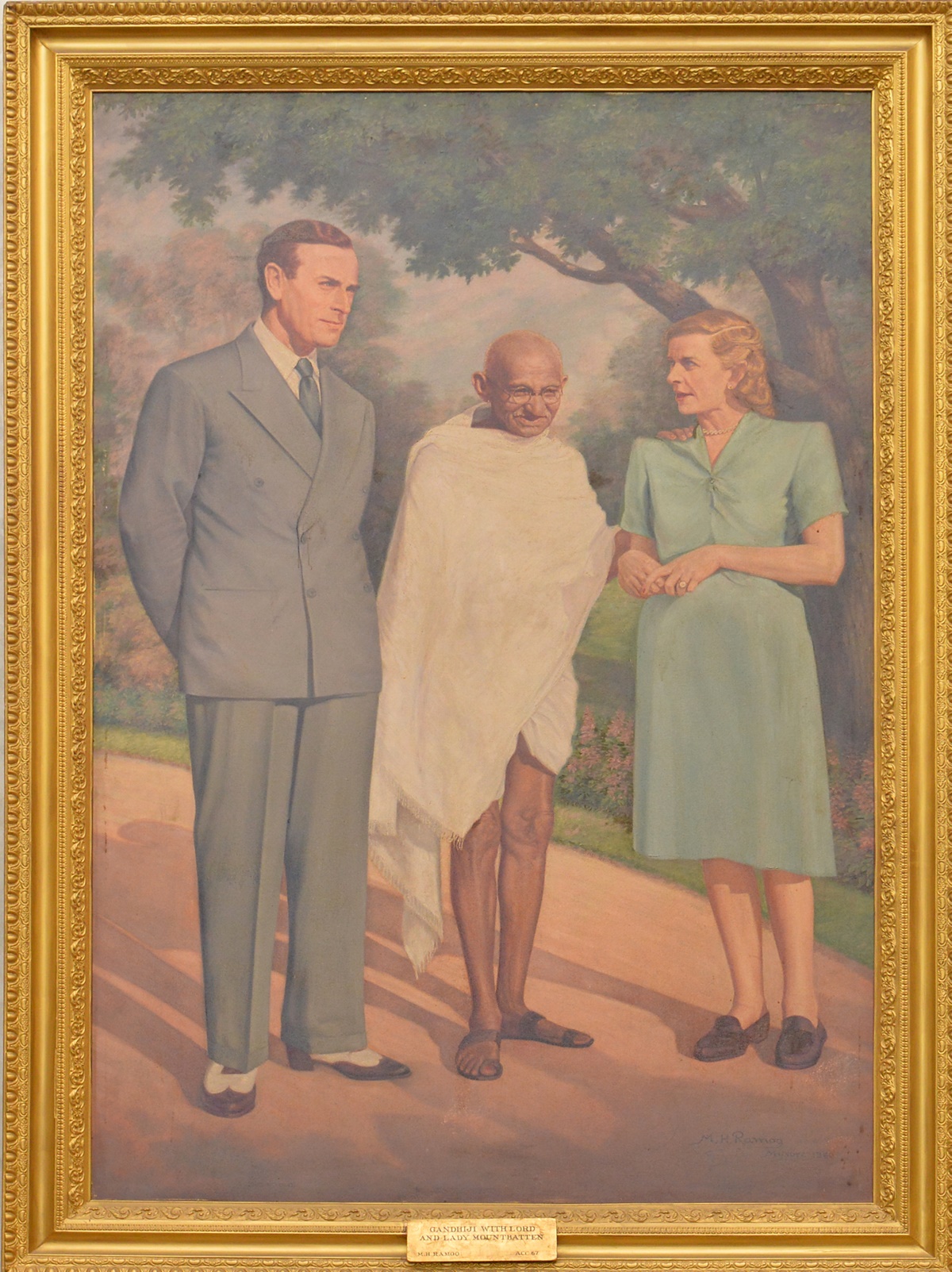 MH Ramoo’s painting of Gandhi with the Mountbattens (Courtesy: Rashtrapati Bhavan Archives)
MH Ramoo’s painting of Gandhi with the Mountbattens (Courtesy: Rashtrapati Bhavan Archives)
Gandhi did not live to see India adopting the Constitution and becoming a Republic on January 26, 1950. Since 1930, this date had been celebrated as purna swaraj (complete independence) day, following the call he had given. Preserving his memories is the only tribute a grateful nation can pay to him.
Ajay Singh is Press Secretary to the President of India. Anjali Bakshi is Joint Director at the Rashtrapati Bhavan
Apr 26: Latest News
- 01
- 02
- 03
- 04
- 05

















